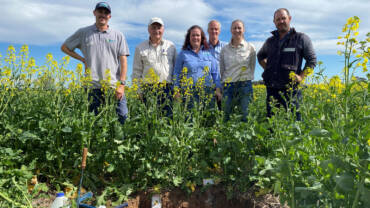Understanding the value of manure as a phosphorous source
| Posted Dec 19,2024Soil CRC PhD student Maryam Barati credits her family for creating an environment where education and analytical thinking were both encouraged and valued. While her family consists of engineering, legal, medical and business professionals, Maryam’s interests led her to pursue a career in agricultural science.
“I have always been interested in food and food production and also realised that Australia is a country that has a strong focus on food production – for example, it ranks as the second or third largest exporter of wheat in the world, producing 14 to 17% of world’s wheat exports,” Maryam said.
“This alignment motivated me to immigrate to Australia in 2016, where I hoped to apply the principles of agricultural science to address practical challenges in nutrient management and soil health.”
Maryam worked in various roles assisting scientific studies – mostly in grain production – before her curiosity led her to embark on a Soil CRC PhD in phosphorus (P) use efficiency of mineral and manure P sources.
She first completed her Honours in nitrogen use efficiency at Charles Sturt University before starting her PhD at Southern Cross University.
“I wanted to improve my understanding of the key decisions that farmers have to make to produce food,” Maryam said. “Many people might take this for granted – but for me, it was something that sparked my interest and stayed with me.”
Maryam’s PhD research set out to establish if manures used as a P source had similar agronomic value to mineral P fertilisers, such as monoammonium phosphate (MAP).
“I essentially set up a rate response methodology to address this question and balance for all nutrients except P,” Maryam explained.
“Many of the experiments I conducted went through to grain yield, so I was able to calculate the fertiliser source rate to achieve 95% of maximum grain yield, which is often referred to as the critical grain yield P requirement.”
Maryam’s study found that:
- manures can match or exceed MAP’s agronomic value, depending on soil type (different physicochemical characteristics such as P buffering capacities), application method (incorporation or banding), and assessment time of crop development
- manures are more effective in high P-sorbing soils but typically require higher application rates
- providing estimates of P application rates for crop production with manures can rely on total P content of the manure rather than using orthophosphate values.
Maryam said her research will help grain growers by bridging critical knowledge gaps regarding soil regulation of phosphorous bioavailability.
Based on current prices, this study’s immediate impact will be to reduce input costs for grain growers by substituting MAP for manure so greater profit margins can be achieved. This will be accomplished by:
- raising awareness of manures as a nutrient source
- determining the true value of animal manures relative to inorganic fertiliser on a crop response basis
- identifying any additional value provided to grain crop production when manures are used.
“The pathway to market is partly in place, with some grain growers already switching to organic manures as a lower-cost supply of phosphorous,” Maryam said.
“As the research further highlights the potential benefits of using organic manures as a phosphorous substitute or co-contributor to crop phosphorous requirements, it can also help to improve recycling in intensive livestock industries.”
This research contributes to a Soil CRC project (3.1.005) led by Professor Terry Rose at Southern Cross University, which is determining the fertiliser value of animal manures and developing recommendations for the use of manures and new organic amendment products.
When asked what she valued most about her PhD experience, Mayram highlighted the growth opportunities it provided, particularly in developing her analytical skills.
“My PhD has enhanced my skillset in data analysis and modelling and improved my interpretation skills, specifically for the experimental results that may have been unexpected, which occurred for me in some of the micro-nutrient responses, even where I ensured these factors where not limiting in the soil,” she said.
“I acknowledge the valuable contributions of my former and current supervisors, as well as the great scientists I have had the opportunity to work with, in nurturing these skills.
“I also acknowledge the support of the Soil CRC and its staff – it has been a privilege to be part of a nationwide cohort of PhD students and I’m grateful for the opportunity it provided to develop my industry knowledge and skills.”
Three years and five months after starting her PhD, Maryam has now submitted her thesis and is writing a number of research papers.
“I am keen to take on a post-doctoral or research position and looking forward to where that might take me professionally and personally,” she concluded.
In the meantime, you will find Maryam spending time with her much-treasured cat, Tillie, who is delighted to have her owner’s undivided attention until the next adventure calls.
Find out more
Stay tuned for Maryam’s upcoming publications:
- Agronomic phosphorus fertiliser value of animal manures compared to mineral fertiliser for wheat in a sandy soil
- Soil type driven differences in agronomic and residual fertiliser value from animal manure and mineral phosphorus sources
- Comparing wheat phosphorus uptake from manure and mineral phosphorus sources in soils with varied buffering capacities using 33P labelling





